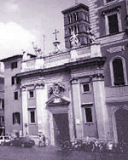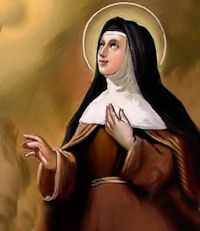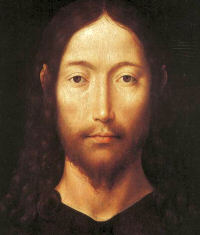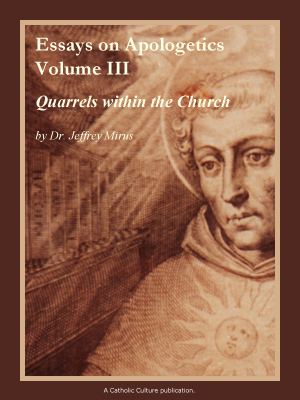Lent: March 6th
Thursday of the Fourth Week of Lent
Other Commemorations: St. Colette, Virgin and Religious (RM)
» Enjoy our Liturgical Seasons series of e-books!
But I have testimony greater than John's. The works that the Father gave me to accomplish, these works that I perform testify on my behalf that the Father has sent me. Moreover, the Father who sent me has testified on my behalf. But you have never heard his voice nor seen his form, and you do not have his word remaining in you, because you do not believe in the one whom he has sent (John 5:36-38).
According to the 1962 Missal of Bl. John XXIII today is the feast of Sts. Perpetua and Felicity. Their feasts in the Ordinary Form of the Roman Rite is celebrated on March 7.

The Station is at the church of Saints Sylvester and Martin, which is one of the most venerable in Rome. It was originally built by Pope St. Sylvester, and still bears his name: but in the sixth century, it was consecrated to St. Martin of Tours. In the seventh century, it was enriched with the relics of Pope Saint Martin, which were brought from Chersonesus, where he had died a martyr a few years before. This church was the first Title of St. Charles Borromeo. It was also that of the learned liturgiologist, the Blessed Joseph-Mary Tommasi, whose body is now venerated in this church, and has been miraculously preserved, even to this day, in a state of incorruption.
Meditation - God's Appeal to All the World
Pilate's "Ecce, Homo!" his appeal to the scornful multitude now on the point of breaking out into mob violence, was even more truly the mighty appeal of God's marvelous mercy to his chosen people and to all the human race.
"Behold the Man!" Behold the Lamb of God, the Son of the living God, in all these unsightly wounds, the most beautiful of men here disfigured beyond recognition, as one stricken by leprosy and all the other filthy diseases of mankind; yes, behold Him here, the most frightful symbol and demonstration of the monstrous evil of mortal sin ever to be given to the world; but even more, behold Him here, the clearest and the mightiest appeal of Heaven to all the world of souls to be converted and to rise from spiritual death to life, true and even divine.
"Behold the Man." O my soul, behold Christ Jesus there as the Lamb of God loaded with your own personal sins and bearing the ghastly wounds your sins inflicted on Him. Pray that you may recognize here, in this reed and purple and crown, God's very own caricature of your senseless pride, of the folly of your imaginary greatness. In that purple rag of a cloak see the sham honor and dignity in which your self-conceit and self-complacency clothe you! In that reed recognize the might of your strength in which you have been trusting. In that crown acknowledge the depth of humiliation you deserve for all your vanity and your open and secret envious ambition for recognition and authority and for honors and offices. O my soul, be honest enough to see and to acknowledge what a spectacle you are to all heaven in the light of the revelation in God's word: "Behold the Man!"
Yet again, "Behold the Man!" Look on Him that you may be filled with hope and courage. Let the crushing truth you have just been making your very own, serve to crush your nauseating and contaminating pride in all its open and especially its hitherto hidden forms. Behold the Man, the Lamb of God laden with your sins, but only to wash them away and to cast them into the deep sea of oblivion; yes, and even to take away your stony heart and give you a heart of flesh, to put His own spirit in your midst, and to cause you to walk in His commandments and to keep His judgments and to do them (Ezech. 36:26-30); in a word, to make a way in your wilderness, that shall be called "The Holy Way." (Isa. 35:6-8.)
Excerpted from Our Way to the Father, Rev. Leo M. Krenz, S.J.
St. Colette
 Born in 1380, Nicolette was named in honor of St. Nicholas of Myra. Her loving parents nicknamed her Colette from the time she was a baby. Colette's father was a carpenter at an abbey in Picardy. Quiet and hard-working, Colette was a big help to her mother with the housework. Her parents noticed the child's liking for prayer and her sensitive, loving nature.
Born in 1380, Nicolette was named in honor of St. Nicholas of Myra. Her loving parents nicknamed her Colette from the time she was a baby. Colette's father was a carpenter at an abbey in Picardy. Quiet and hard-working, Colette was a big help to her mother with the housework. Her parents noticed the child's liking for prayer and her sensitive, loving nature.
When Colette was seventeen, both her parents died. The young woman was placed under the care of the abbot at the monastery where her father had worked. She asked for and received a hut built next to the abbey church. Colette lived there. She spent her time praying and sacrificing for Jesus' Church. More and more people found out about this holy young woman. They went to see her and asked her advice about important problems. They knew that she was wise because she lived close to God. She received everybody with gentle kindness. After each visit, she would pray that her visitors would find peace of soul. Colette was a member of the Third Order of St. Francis. She knew that the religious order of women who followed St. Francis' lifestyle are the Poor Clares. They are named after St. Clare, their foundress, who was a follower of St. Francis. During Colette's time, the Poor Clares needed to go back to the original purpose of their order. St. Francis of Assisi appeared to Colette and asked her to reform the Poor Clares. She must have been surprised and afraid of such a difficult task. But she trusted in God's grace. Colette traveled to the Poor Clare convents. She helped the nuns become more poor and prayerful.
The Poor Clares were inspired by St. Colette's life. She had a great devotion to Jesus in the Eucharist. She also spent time frequently meditating on the passion and death of Jesus. She loved Jesus and her religious vocation very much.
Colette knew exactly when and where she was going to die. She died in one of her convents in Ghent, Flanders, in 1447. She was sixty-seven. Colette was proclaimed a saint by Pope Pius VI in 1807.
—Excerpted from Holy Spirit Interactive
Symbols and Representation: birds; lamb; woman being carried to heaven by an angel; woman delivering a soul from purgatory; Poor Clare nun holding a crucifix and a hook; Poor Clare nun visited by Saint Anne, Saint Francis of Assisi, and/or Saint Clare of Assisi in a vision; Poor Clare nun walking on a stream
Patronage: against eye disorders; against fever; against headaches; against infertility; against the death of parents; craftsmen; Poor Clares; servants; Corbie, France; Ghent, Belgium
Highlights and Things to Do:
- Read more about St. Colette:
- The Colettines are a reformed branch of the Poor Clares. See the Ty Mam Duw Poor Clare Colettine Community for an example of one of the communities.
- St. Colette's relics are at Monastère Sainte-Claire in Poligny, France.






